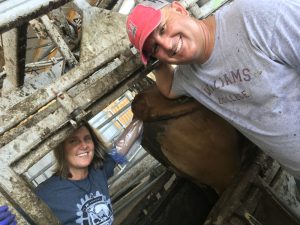Buying a bull is much like buying a truck – you must have clearly defined goals and be willing to spend a chunk of change. The first step is to define your operational goals. To stick with the analogy, is this truck going to pulling a 34-ft Yellowfin boat with twin 300 Yamaha engines to the Atlantic or is it going to be towing a jet ski to the nearby lake? Do you need the bull to breed your entire herd or is he going to be the “cleanup” bull? For natural breeding operations, the general rule of thumb is to have one bull per 25 cows and to get those cows bred within a 60 to 90-day breeding season. However, if estrus synchronization and artificial insemination (AI) is part of your cattle program, then you can expect at least 50% of your herd to be bred artificially and trust the “cleanup” bull for the remaining “open” cows. This approach certainly takes a little pressure off the bull and allows for a higher bull to cow ratio.


The goal of all beef cow-calf operations is for mama’s to put babies on the ground once every 365 days. Once that number creeps into every 13, 14, and 15 months, then reproductive efficiency goes down and profit margins are diminished. For example, let’s say “Betsy” has a calving interval of 12 months, she will hopefully produce 10 calves in 10 years, which would mean $7800 over her lifetime (assuming an average calf price of $780). Let’s say that “Delilah” has a 15-month calving interval and produces only 8 calves in 10 years, which results in a $1560 loss when compared to Betsy. Delilah is providing less returns but still requiring the same costs for feeding, vaccinations and veterinarian costs as Betsy. So calving intervals clearly affect profitability and are directly related to bull fertility. For more specific information on economics associated with beef reproductive efficiencies, please see the following link: https://nwdistrict.ifas.ufl.edu/phag/2019/07/12/improving-the-reproductive-efficiency-of-beef-cattle-herds/
Bull fertility can be measured by a breeding soundness exam typically performed by a veterinarian. These exams consist of both internal and external evaluations that result in either “satisfactory”, “unsatisfactory” or “classification deferred.” Physical soundness relates to the ability of the bull to see, smell, walk and mount cows easily. Semen samples are collected to evaluate sperm morphology and motility. Internal and external exams are conducted to ensure healthy reproductive organs. Scrotal circumference (i.e. distance around the scrotal sack in centimeters) is a threshold value and moderately heritable trait that can be measured and compared with other bulls within the same breed. Scrotal circumference will increase as the bull comes into maturity, but threshold values are available that determine whether or not the bull will pass a breeding soundness exam. Size certainly matters when it comes to scrotal circumferences since this is a direct measure of testes volume and sperm producing material. Higher sperm counts mean more chances for pregnancy. More detailed information on breeding soundness and guidelines for scrotal circumferences in specific breeds can be found at https://aglifesciences.tamu.edu/animalscience/wp-content/uploads/sites/14/2012/04/beef-breeding-soundness-bulls.pdf
To be economically viable within beef cattle operations, you need to breed as many cows as possible within the shortest timeframe possible. Short breeding seasons (i.e. 90 days or less) mean that calf ages will be consistent across the herd and this is important for calf maintenance. Working calves (i.e. providing vaccinations and performing castrations) is an expensive and labor-intensive task that is much easier to handle when the calves are relatively the same age. Thus, bull fertility plays an important role in the maintenance and success of the beef cattle operation. Breedness soundness exams should be performed annually since bull health and performance changes from year to year. They are also recommended 30 to 60 days prior to the breeding season to provide ample time to replace your bull if necessary.
 0
0
